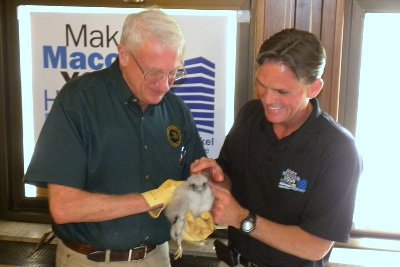Macomb County peregrine falcons are males
 The Department of Natural Resources, in partnership with Macomb County and the Detroit Zoo, banded two healthy, male peregrine falcon chicks last week. The banding occurred on the 11th floor of the Macomb County Building in Mount Clemens. The chicks, hatched on May 1, are the offspring of Hathor and Nick, longtime residents of the Macomb County Building.
The Department of Natural Resources, in partnership with Macomb County and the Detroit Zoo, banded two healthy, male peregrine falcon chicks last week. The banding occurred on the 11th floor of the Macomb County Building in Mount Clemens. The chicks, hatched on May 1, are the offspring of Hathor and Nick, longtime residents of the Macomb County Building.
Pictured above: DNR Southeast Regional Wildlife Supervisor TimPayne (left) and Macomb County Executive Mark Hackel.
Hathor hatched at the Pittsburgh Cathedral of Learning in 2003 and arrived at the Macomb County Building site in 2004. Nick arrived in 2008, having hatched at the Whittier Hotel in Detroit in 2006. The pair has hatched 16 offspring since 2008.
DNR Southeast Regional Wildlife Supervisor Tim Payne and Detroit Zoo Curator of Birds Tom Schnieder banded the chicks, while Macomb County Executive Mark Hackel named the chicks Wayne and Oakland. Hackel chose the names to honor the cooperative partnership between the three Detroit metropolitan counties. “I’ve been naming the birds for three years now, and it’s an honor that I enjoy,” said Hackel.
Wayne and Oakland were outfitted with two bands. The band on each bird’s left leg is red and black, with numbers that can be read from up to a mile away with a spotting scope. On their right leg is an aluminum U.S. Fish and Wildlife Service band with an official tracking number. Both bands will be used to identify the birds after they leave the nest.
Once on the brink of destruction due to pesticide use, peregrine falcons have recovered through extensive re-introduction efforts. Michigan began reintroducing peregrines to the Detroit area in 1987, and since then, 232 chicks have hatched in the region. There are currently 15 known nesting sites in southeast Michigan, with two sites in Macomb County – the Macomb County Building and the Campbell Ewald Building in Warren.
“This is fun,” said Payne. “This is the rewarding part of my job, seeing this species recover.”





